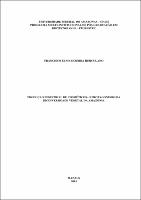| ???jsp.display-item.social.title??? |


|
Please use this identifier to cite or link to this item:
https://tede.ufam.edu.br/handle/tede/3087Full metadata record
| DC Field | Value | Language |
|---|---|---|
| dc.creator | Herculano, Francisco Elno Bezerra | - |
| dc.creator.Lattes | http://lattes.cnpq.br/9182107273703198 | por |
| dc.contributor.advisor1 | Veiga Junior, Valdir Florêncio da | - |
| dc.contributor.advisor1Lattes | http://lattes.cnpq.br/0581412073128121 | por |
| dc.contributor.advisor-co1 | Pereira, José Odair | - |
| dc.contributor.advisor-co1Lattes | http://lattes.cnpq.br/5559640659851194 | por |
| dc.date.available | 2015-04-08 | - |
| dc.date.issued | 2013-04-22 | - |
| dc.identifier.citation | HERCULANO, Francisco Elno Bezerra. Produção industrial de cosméticos: o protagonismo da biodiversidade vegetal da Amazônia. 2013. 146 f. Tese (Doutorado em Biotecnologia) - Universidade Federal do Amazonas, Manaus, 2013. | por |
| dc.identifier.uri | http://tede.ufam.edu.br/handle/tede/3087 | - |
| dc.description.resumo | Este trabalho busca analisar a emergente utilização de ativos da biodiversidade vegetal amazônica na produção comercial de cosméticos por parte de indústrias localizadas em Manaus, no restante do Brasil e no exterior e o apelo comercial da região. A partir de pesquisas realizadas em uma amostra de 20 empresas do respectivo segmento, observou-se que duas dezenas de espécies regionais representadas principalmente por subprodutos como óleos, extratos, resinas, essências e gorduras vegetais estavam sendo aproveitadas como ingredientes na composição de cosméticos. Os resultados mostraram que na atualidade essa indústria avança independentemente de qualquer juízo de valor, sobre tradicionais e novos recursos da biodiversidade regional, seja planta aromática, alimentícia ou medicinal. As espécies mais demandadas foram castanha-da-Amazônia (Bertholletia excelsa Humb), andiroba (Carapa guianensis Aubl), açaí (Euterpe oleracea/precatória Mart), cupuaçu (Theobroma grandiflorum Willd. ex Spreng. Schum), buriti (Mauritia flexuosa L.), mulateiro (Calycophyllum spruceanum Benth) e copaíba (Copaifera spp). O apelo ou a promoção comercial vinculando o nome da Amazônia também foi constatado como prática nas empresas, sugerindo a inserção estratégica do ingrediente regional, não apenas como elemento técnico, mas também como ferramenta de competitividade no escopo da gestão mercadológica corporativa. Ficou caracterizada, ainda, a participação de essências sintéticas de diversas plantas regionais na composição de vários cosméticos, aludindo a um cenário de relativização da importância dessa biodiversidade como fator de vantagem competitiva para a região. O quadro sugere um novo viés de esvaziamento como ocorreu com a borracha, com o diferencial de afetar um segmento antes mesmo que ele se torne economicamente tão expressivo como aquele, mas que poderá ser superado com políticas públicas efetivas e específicas para a realidade de uma região estratégica para o Brasil | por |
| dc.description.abstract | This study seeks to examine the emerging use of assets of Amazonian plant biodiversity in the commercial production of cosmetics by industries located in Manaus, in the rest of Brazil and abroad, and the commercial appeal of the region. From research carried out on a sample of 20 companies in the respective sector, it was found that two dozen regional species, represented mainly by by-products such as oils, extracts, resins, essential oils and vegetable fats, were being used as ingredients in the composition of cosmetics. The results showed that currently this industry moves forward regardless of any value judgement, on traditional and new resources of regional biodiversity, whether it is a herbal, nutritional or medicinal plant. The assets most in demand were castanha-da-Amazônia (Bertholletia excelsa Humb), andiroba (Carapa guianensis Aubl), açaí (Euterpe oleracea/precatoria Mart), cupuaçu (Theobroma grandiflorum Willd. ex Spreng. Schum), buriti (Mauritia flexuosa L), mulateiro (Calycophyllum spruceanum Benth) and copaíba (Copaifera spp). The appeal or the commercial promotion linking the name of Amazonia has also been found as a practice in companies, suggesting the strategic introduction of the regional ingredient, not only as a technical item, but also as a tool for competitiveness in the scope of corporate marketing management. The involvement of synthetic essential oils of several regional plants in the composition of various cosmetics has also been characterised, referring to a scenario in which the importance of this biodiversity as a factor of competitive advantage for the region becomes relative. The picture suggests a new trend of depletion as happened with rubber, with the distinguishing factor of affecting a sector even before it becomes economically as significant as the former, but which could be overcome with effective and specific public policies for the situation of a region which is strategic for Brazil | eng |
| dc.format | application/pdf | por |
| dc.thumbnail.url | http://200.129.163.131:8080//retrieve/10161/Francisco%20Elno%20Bezerra%20Herculano.pdf.jpg | * |
| dc.language | por | por |
| dc.publisher | Universidade Federal do Amazonas | por |
| dc.publisher.department | Instituto de Ciências Biológicas | por |
| dc.publisher.country | BR | por |
| dc.publisher.initials | UFAM | por |
| dc.publisher.program | Programa de Pós-Graduação em Biotecnologia | por |
| dc.rights | Acesso Aberto | por |
| dc.subject | Gestão | por |
| dc.subject | Biodiversidade | por |
| dc.subject | Espécies vegetais amazônicas | por |
| dc.subject | Management | eng |
| dc.subject | Biodiversity | eng |
| dc.subject | Vegetables amazonian s species | eng |
| dc.subject.cnpq | CIÊNCIAS BIOLÓGICAS | por |
| dc.title | Produção industrial de cosméticos: o protagonismo da biodiversidade vegetal da Amazônia | por |
| dc.type | Tese | por |
| Appears in Collections: | Doutorado em Biotecnologia | |
Files in This Item:
| File | Description | Size | Format | |
|---|---|---|---|---|
| Francisco Elno Bezerra Herculano.pdf | 1.64 MB | Adobe PDF |  Download/Open Preview |
Items in DSpace are protected by copyright, with all rights reserved, unless otherwise indicated.




